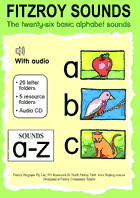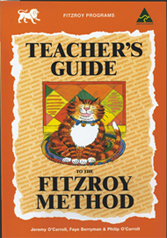|
Fitzroy
Alphabet Book
Provides 50 worksheets for sounding and writing
the alphabet. Includes alphabetical order and two-letter words.
Leads directly into the Readers and the Word Skills. This book
has 50 x A4 pages designed for absolute beginners. The first 5
pages help with the forming of lines and circles. Then there is
a page for each letter - help with writing, sounding and recognising.
There are many activity pages helping with discrimination, alphabetical
order, and forming two-letter words.
The
activities in this Alphabet Book are designed for absolute beginners,
including pre-writing and letter formation. They are complete
preparation for Fitzroy Readers 1 to 10 and for the Fitzroy Word
Skills Activity Book 1.
Fitzroy
Alphabetics Game
This
is a word-making game using English letters and digraphs. There
are two types of activities, one for beginners, and the other
for older children and adults (50 possible levels).
The
package contains graded word lists, clear instructions for the
teaching activities and rules for the higher table games. Now
with a SHORT RULES sheet for those who want to get straight into
the game. It is ideal for helping slow beginners. Also includes
enjoyable after-dinner game for literate adults.
|
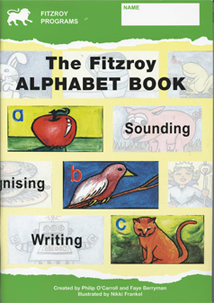
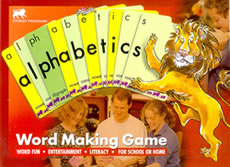
|
|
The
Fitzroy Method: Brief Explanation
The
Fitzroy Program of Readers and Word Skills is not an ordinary
set of story books and written activities with some phonics hints
thrown in. It is systematic phonics.
You
teach letters of the alphabet and the sounds they represent. You
explain that a written word is a string of letters showing sounds
from the left to right.
You
teach children the skill of decoding English as they encounter
it outside the classroom.
There
are hundreds of thousands of English words. You cannot hope to
teach them all! That's why the Fitzroy Method teaches students
how to approach new words, by understanding sounds and digraphs.
The
Fitzroy Method: How is it done?
Begin
by talking about sounds, then joining of sounds, thus making words.
Our alphabet represents sounds, both by single letters (a, b,
c....) and by digraphs (ch, ew, tion...). From sounds such as
a, h and t we make words such as hat.
The
Fitzroy Readers systematically introduce sounds one by one with
each story. The Fitzroy Method ensures fast progress and successful
remediation because there are no surprises. Each new story uses
only:
- the
sounds and words learned in previous stories,
- the
new sound that this story makes memorable, and
- a
few new special words, that is sight-words which we do not attempt
to sound out, because they do not conform to the rules (at least
not to any that we have learned so far
The
Fitzroy Method: Why it works
Children
like rules. They retain far more if taught rules and exceptions
rather than item-by-item.
Systematic
phonics rewards children with regular victories. It is fun to
know how to decipher a whole new family of words at a time - rather
than having to endure a slow process of rote accumulation.
The
Fitzroy Method is motivating because children love to go home
with new skills that work in the world outside of school, prized
skills that they can demonstrate within their own communities
- such as reading signs, notes, labels, lists, stories, instructions,
dictionaries:-
In
Australia, more than 3500 schools have bought the Fitzroy Readers.
In Singapore, it has grant its footing that apart from Schools,
parents are using them! We recommend them to you.
For
more details on the Phonic Approach and the Fitzroy Program, click
here
|
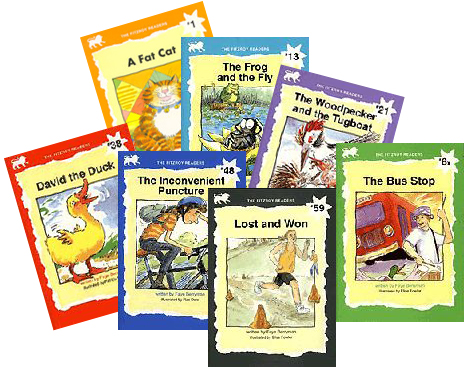
For
a brief glimpse of the Fitzroy range, please click the below image to
download the flyer or click
here (approx. 200 KB)
|
Fitzroy
Readers
Fitzroy
Readers (10 Titles) 1 - 10
Fitzroy
Readers (10 Titles) 1x - 10x
Fitzroy
Readers (10 Titles) 11 - 20
Fitzroy
Readers (10 Titles) 21 - 30
Fitzroy
Readers (10 Titles) 31 - 40
Fitzroy
Readers (10 Titles) 41 - 50
Fitzroy
Readers (10 Titles) 51 - 60
Suitable
for beginners who have learned most of the sounds of the alphabet.
Readers 1-10 use only basic sounds, except for Story 9, which
introduces the diagraph oo as in roof.
Readers 11-60 features a basic English sound (eg. oy), a few sight
words (eg.said), a revision word list and an extension word list.
|
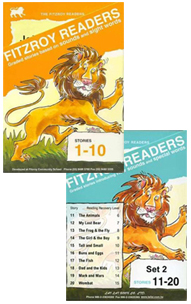
|
| |
Fitzroy
Readers (10 Titles) 1 - 10 |
|
Fitzroy
Readers (10 Titles) 1x - 10x |
| 1 |
A
Fat Cat |
1x |
Ann
and Mal |
| 2 |
A
Big Pig |
2x |
Tom
Cat and Jim Rat |
| 3 |
Bug
on a Rug |
3x |
The
Mud Hut |
| 4 |
Dot |
4x |
Ants
at the Camp |
| 5 |
The
Pet Hen |
5x |
The
Big Mass |
| 6 |
Fox
on the Box |
6x |
The
Sick Dog |
| 7 |
I
Can Run |
7x |
The
Land of Zond |
| 8 |
The
Picnic |
8x |
The
Bus Stop |
| 9 |
My
Pup |
9x |
The
Billabong |
| 10 |
John
and His Fox |
10x |
Cat
and Kitten |
| |
Fitzroy
Readers (10 Titles) 11 - 20 |
|
Fitzroy
Readers (10 Titles) 21 - 30 |
| 11 |
The
Animals |
21 |
Woodpecker |
| 12 |
My
Lost Bear |
22 |
Rabbit
Wants a Carrot |
| 13 |
The
Frog & the Fly |
23 |
The
Girls & the Ball |
| 14 |
The
Girl & the Boy |
24 |
Cat,
Dog & Vet |
| 15 |
Tall
and Small |
25 |
Tom
and Benji |
| 16 |
Buns
and Eggs |
26 |
Eight
Frogs & Snake |
| 17 |
The
Fish |
27 |
Tabitha
and Thug |
| 18 |
Dad
and the Kids |
28 |
Love |
| 19 |
Mark
and Mars |
29 |
Owl
and the Clown |
| 20 |
Wombat |
30 |
Jessica |
| |
Fitzroy
Readers (10 Titles) 31 - 40 |
|
Fitzroy
Readers (10 Titles) 41 - 50 |
| 31 |
Kate
& the Rake |
41 |
Tim
Comes to Stay |
| 32 |
The
Boat |
42 |
The
Bear Next Door |
| 33 |
On
the Hill |
43 |
Ling
Goes to China |
| 34 |
The
Cat & the Fish |
44 |
Cindy's
Trip to Perth |
| 35 |
Dolly
Duck |
45 |
Sir
John & Bear Brothers |
| 36 |
Captain
Hornblower |
46 |
Arthur
& the Crayfish |
| 37 |
Flying
Doctor |
47 |
The
New Year Party |
| 38 |
David
the Duck |
48 |
Inconvenience
Puncture |
| 39 |
Silas
the Cat |
49 |
The
Grass is Greener |
| 40 |
Shawn
& the Go-Cart |
50 |
The
Wisdom of Solomon |
| |
Fitzroy
Readers (10 Titles) 51 - 60 |
|
|
| 51 |
Paul's
Principle |
|
|
| 52 |
The
Dirt Track |
|
|
| 53 |
Athlete
Pete |
|
|
| 54 |
Meeting
the Challenge |
|
|
| 55 |
Transported |
|
|
| 56 |
David
& Goliath |
|
|
| 57 |
Excavations |
|
|
| 58 |
Andrew
& Diana |
|
|
| 59 |
Lost
& Won |
|
|
| 60 |
The
Facts of Life |
|
|
^
TOP ^
|
Fitzroy
Word Skills 1 to 5
Workbooks
to use alongside the Readers.
Book 1 to 5 support a set of 10 readers, devoting 7 pages of activities
to each story.
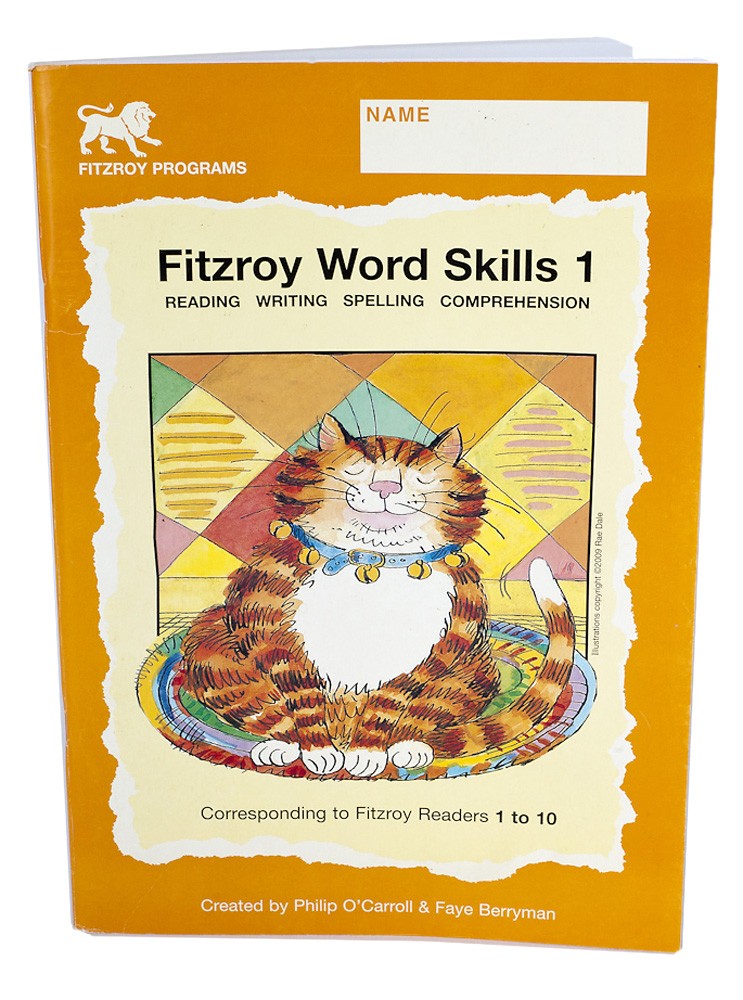 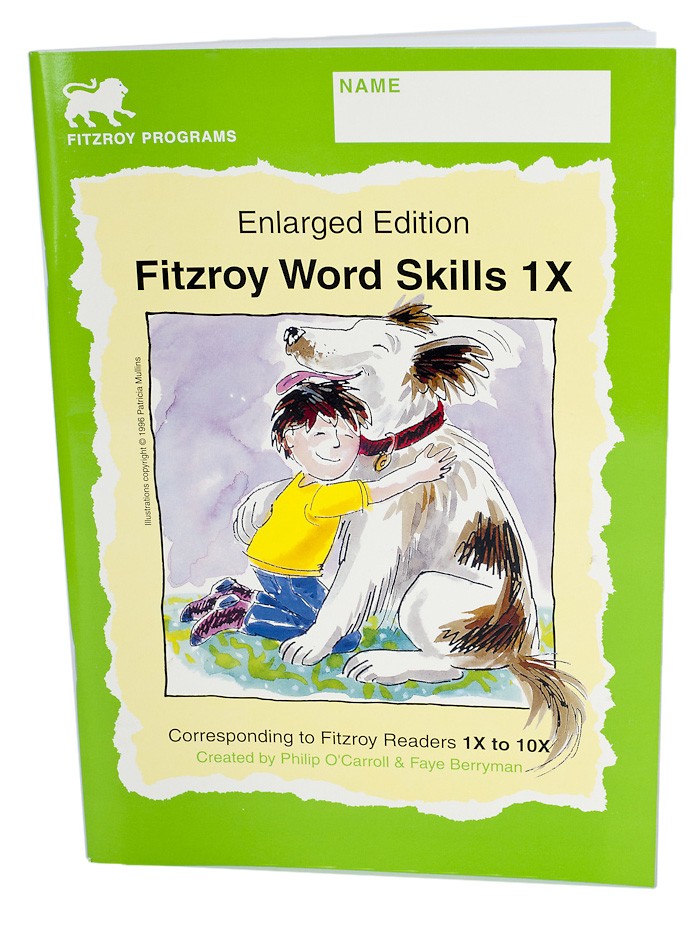 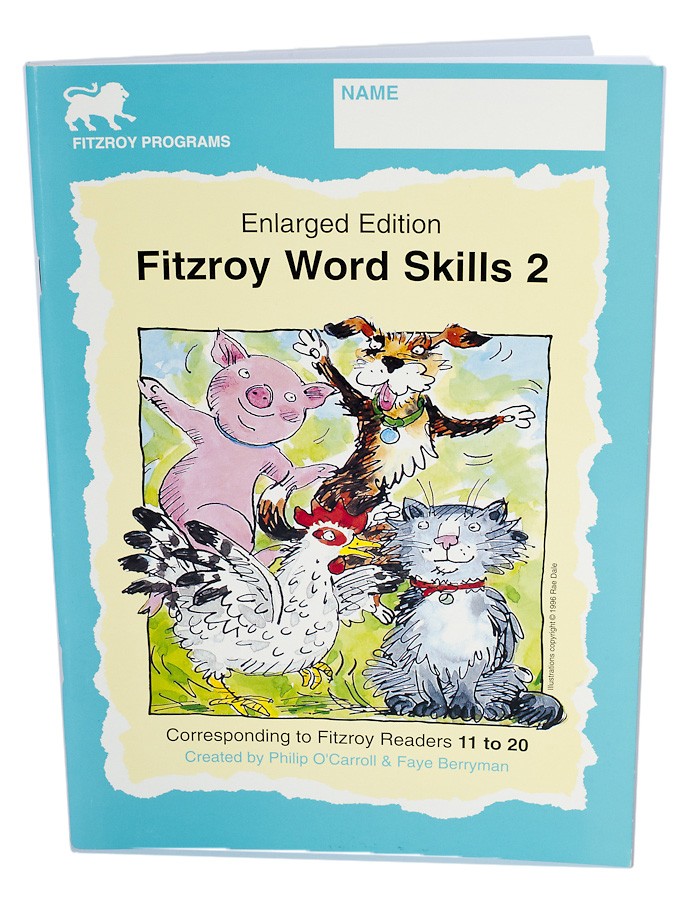 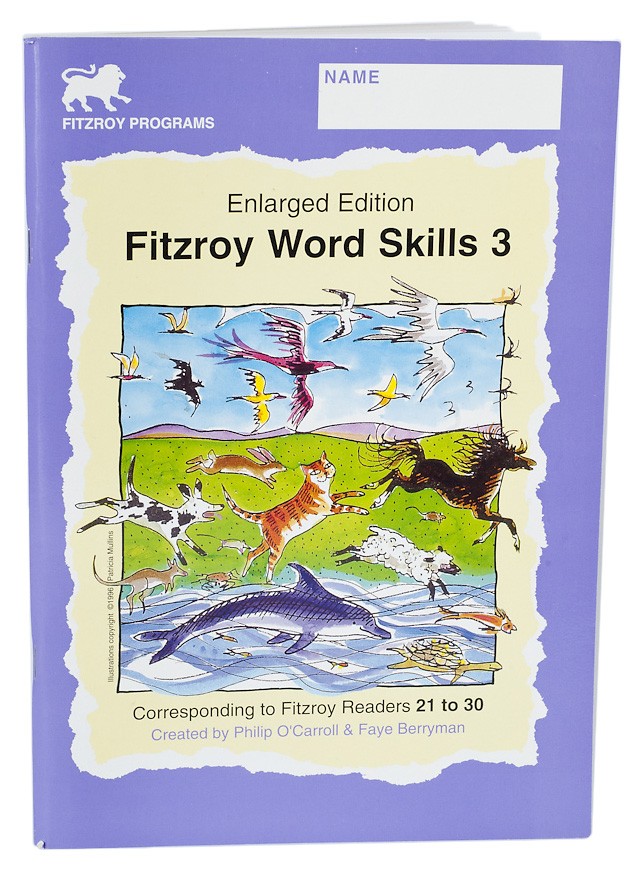 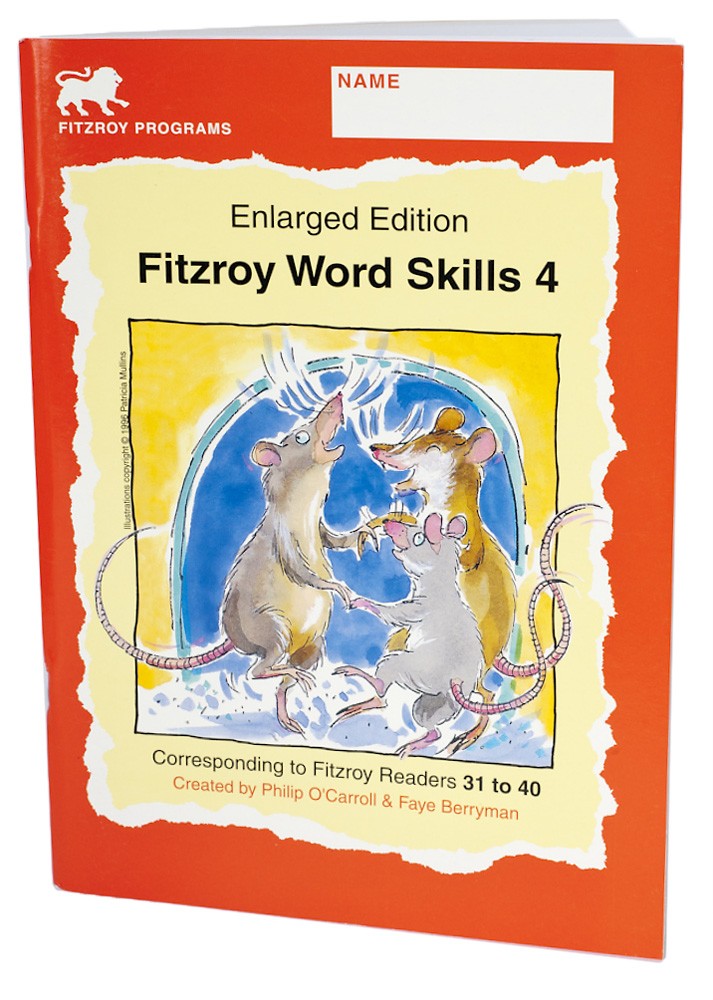 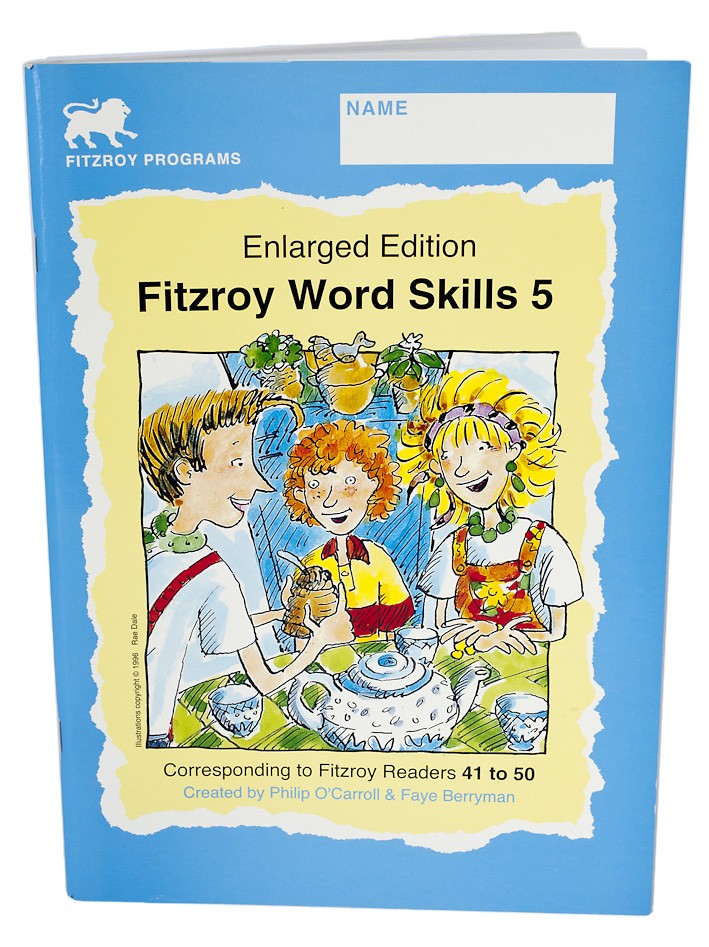
Word Skills 6A & 6B are carefully designed so
as not to waste time on unnecessary and abstruse matters. It is
practical for today’s world. It enables students:
1.
to speak intelligently about the structure of English
2.
to use English correctly in ways which are still considered important
in today's world
3.
to know the standard terms of grammar, noun, verb, prefix, tense,
preposition, etc - exactly as they are used in the world today
in publishing, journalism, philosophy, etc
4.
to have the necessary grammatical knowledge to tackle a language
other than English
5.
to enjoy the workings of English, to expand vocabulary and to
write more artfully.
|
|
Fitzroy
Word Skills 6A
Workbooks
to use alongside the Readers. Books 6A supports stories 51-55
with 14 pages for each story. These Word Skills advance
the student further in spelling, punctuation and basic grammar.
(They also include more advanced activities for the students who
progress faster,) Fitzroy Word Skills Number 6A has the
essentials of grammar for busy modern students. These can be used
by students working on stories 51-55.
Word Skills 6A is designed in A4 size page modules, making
each topic a digestible activity for one session. Written in a
large, generous, easy format, and presented in small logical steps,
this work book provided a friendly approach for anyone trying
to master English grammar.
|
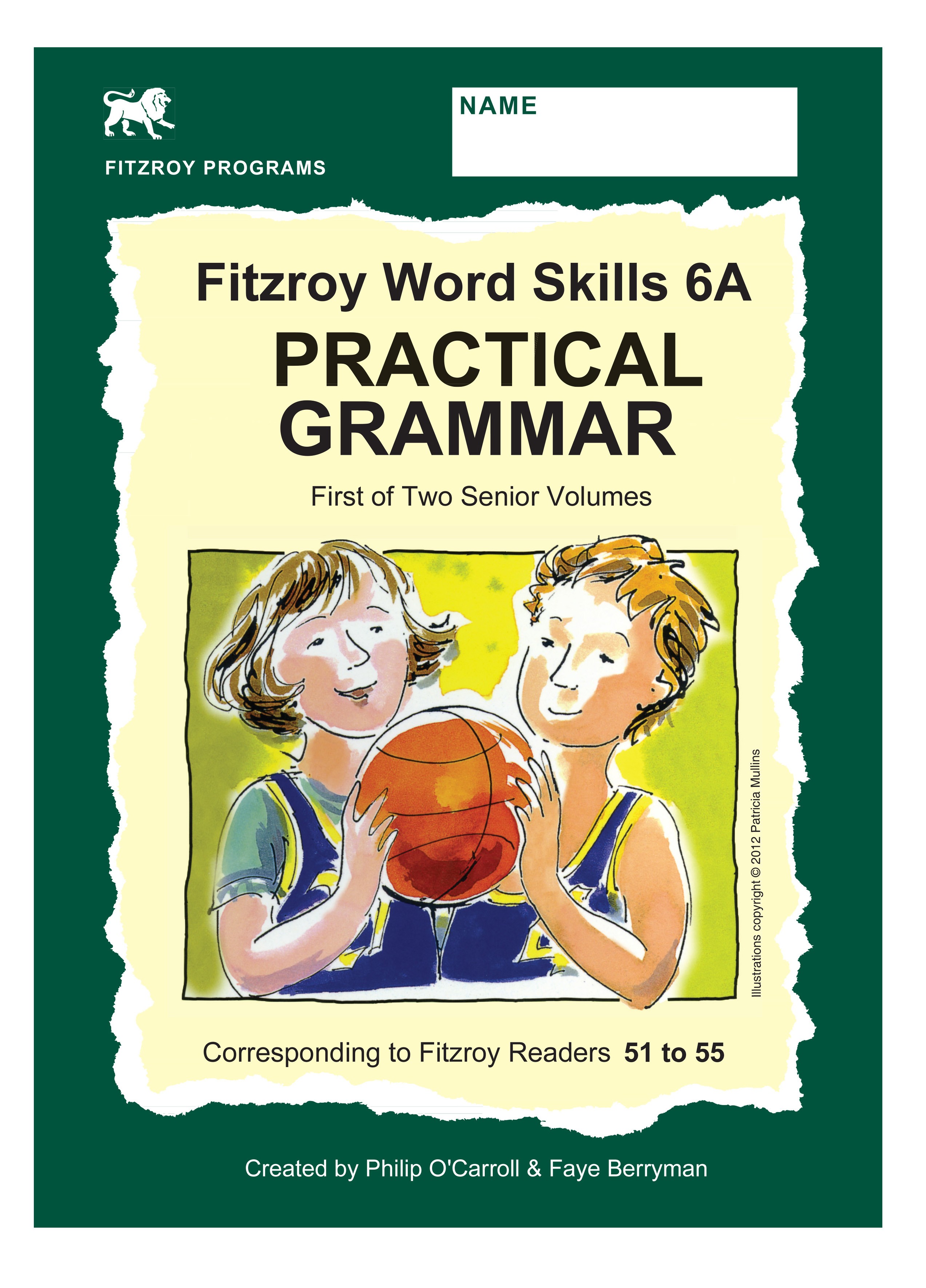 |
|
Fitzroy
Word Skills 6B
Workbooks
to use alongside the Readers. Books 6B supports stories 56-60
with 14 pages for each story. Fitzroy Word Skills Number
6B has the essentials of grammar for busy modern students. These
can be used by students working on stories 56-60.
Word Skills 6B is designed in A4 size page modules, making
each topic a digestible activity for one session. Written in a
large, generous, easy format, and presented in small logical steps,
this work book provided a friendly approach for anyone trying
to master English grammar.
|
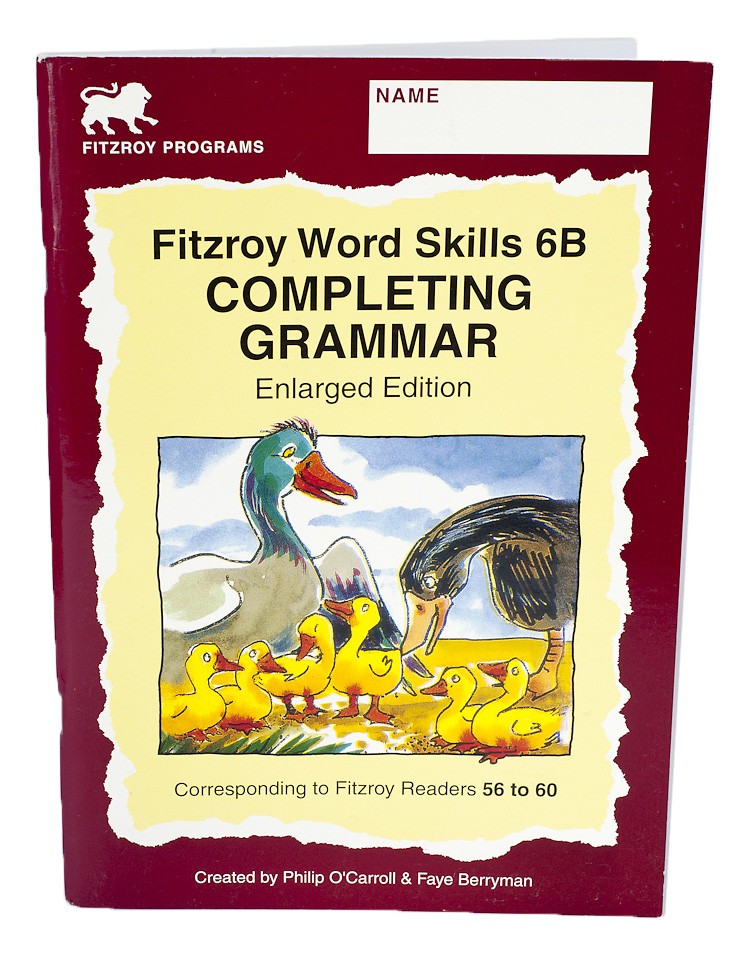 |
|
Fitzroy
Word Skills Answer Books 1 to 5
Answers
provided for Word Skills 1 to 6. Each answer page shows the full
question page with the answers marked in. The level of English
in each worksheet of the Word Skills is taken from the corresponding
Fitzroy Reader.
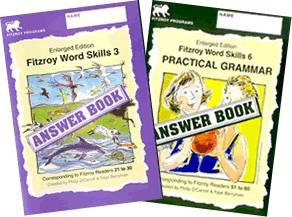
|
|
Fitzroy
Reader Audio CD
Containing
ten of the Reader stories in each CD.
These
are careful pronunciations to cater for ESL students, for slow
students and for story telling.
|
|
|
Fitzroy
Sounds (includes
2 CD's)
The
phonetic disk provides the phonetically correct sound for
each letter. For example, the 'f' sound is voiceless and
continuous as it sounds at the end of 'cliff'. This one
is specially recommended for ESL students.
The
traditional disk provides an alternative way of sounding 13 of
the letters. This is to accommodate teachers who use the traditional
soundings such as 'fhhh!' (voiced ploseive), as in 'fish'
without the 'sh'.
|
|
|
Teacher's
Guide
This
book fills a gap for many teachers who have not yet learned how
to exploit the phonic features of English.
Phonic methods are the secret to early literacy, as has been borne
out by the phenomenal success of our materials in saving the literacy
of many children across the country.
Include
sample lesson plans, spelling list and assessment tools for each
level. This book is especially suitable for the Singapore market
as some ideas are supplied with the help of the Singapore exclusive
distributor, September 21 Enterprise Pte Ltd.
For
more information on the Fitzroy workshop, check out our forthcoming
workshops, click
here
|
|
^
TOP ^
The
Origins of the Fitzroy Readers
The
name of our town, Fitzroy, is known to thousands of children - mostly
in schools across Australia, but also in New Zealand, Taiwan, Singapore
and many other countries. This is because the title Fitzroy Readers
is printed across the top of every copy of seventy children's story
books created here in Fitzroy and published as a series for learning
to read. Over this decade, a million story booklets have been printed.
Back
in the early seventies, we, Faye Berryman and Philip O'Carroll, met
and started up Fitzroy Community School in North Fitzroy, an inner suburb
of Melbourne. Many of the houses here are over a century old, built
in the old English style. The school faces a leafy park, known as the
Edinburgh Gardens. Faye had been a secondary teacher who had seen the
sad outcomes for children who emerged from primary schooling with poor
literacy. Philip had been a philosophy lecturer specialising in logic
and linguistics. Between the two of us, we were determined to come up
with a method of teaching that would ensure that every child could read
well.
The
Fitzroy Readers have helped children in over 3000 schools in Australia,
and many children in other countries. Furthermore, since we published
these, school systems across Australia have gradually re-adopted a phonic
element into their reading programmes.
And
we sometimes wonder who is reading our stories. And we wonder how the
teachers, children and parents who use the Fitzroy Readers in so many
places far and wide, imagine Fitzroy, the source of their seventy stories.
The
Whole Language Approach
Giving
children books and encouraging parents to read to their children is
a lovely thing. However, as government policy, to be implemented as
the weapon against Australia's poor literacy standards, it can only
fail. Not only this, but such a government initiative will lull the
general public into the false security that something practical is being
done to remedy the problem.
It
is a big red herring. The real issue confronting us is the flawed literacy
method used in most of our schools and taught to trainee teachers in
our universities - namely the whole language approach. This approach,
which was taken up by academics and schools over thirty years ago, may
have been well intentioned, but it was/is not well founded.
The
whole language approach is based on the false premise that since children
naturally acquire speech by exposure to the spoken language of the group
they are born into, that the same will hold true for reading and writing.
The theory goes: immerse the children in stories read aloud and they
will naturally come to read and write. The Australian education industry
(including our universities) has failed to acknowledge research findings
- both local and international, and available over the past thirty years
- that the whole language approach would fail many children, and that
a systematic phonic approach to teaching literacy, should be employed.
Humans are genetically endowed with the ability to acquire speech. But
reading and writing are learned skills - as human history has consistently
shown us.
The
first thing that a teacher of English to beginners must do is see how
spoken English is transformed into its written form. English is an alphabetic
language. We use the letters of the alphabet to represent our speech
sounds. Teaching someone to read and write means explaining how the
alphabetic code of English works. This is not done in most of our schools.
Yours
faithfully,
Faye Berryman, English Co-ordinator, Fitzroy Community School.
^
TOP ^
The
Phonic Approach
"The
Phonic Approach" is one of the established methods of teaching
children to read and write English. Its main rival is "The Whole
Language" approach. The Whole Language approach presents children
with words without exploring the sounds of the component letters. The
child is expected to become familiar with the look of the word and remember
the spoken word to which it corresponds.
The
Phonic Approach, by contrast, introduces children firstly to the letters
of the alphabet and their basic sounds. Beginning with simple words,
children learn how words are formed from these component letters. English
uses combinations of letters (eg: sh, th, etc.) to make particular sounds.
And there are of course some English words whose spelling does not conform
to any phonic principles. These words must still be learned as "whole
words".
Objections
to the whole word approach include the fact that children cannot decipher
words they have never seen and are therefore at the mercy of their schooling
for their vocabulary. With the phonic approach children can learn whole
families of words at once - for example the ay words.
Having
learned the sound of ay the student can then read: bay, day, gay, hay,
lay, may, pay, ray, say, way, stay, play, pray, tray, sway, etc.
Phonic
Reading System
Before
you start to read the Fitzroy Readers, you must learn the basic sound
of each letter - A for APPLE, B for BOY, C for CAT etc.
As
well as basic sounds, there are extra sounds, represented by digraphs
such as AY, ALL or EW. Words which are spelled according to the basic
sounds of English and the extra sounds of English are sounding words.
Basic sounds and extra sounds are phonic rules. Most English words are
spelled according to phonic rules.
Each
Fitzroy Reader story teaches a new phonic rule. For example,
Story 15 teaches the extra sound ALL. The sound ALL is listed as the
new sound for Story 15. (·new sound· means the same as
·extra sound·)
Before
you read each Fitzroy Reader, look on the back cover to see what new
sound is being used.
Also
printed on the back cover of each Fitzroy Reader are the special words
used in the new story. These are words which do not follow the phonic
rules we have learned so far.
Some
words are special words because they do not follow any phonic rule,
for example, EYE and THEIR. These are not sounding words, but must simply
be learned by rote.
There
are some words in each story whose phonic rule has not been learned
yet. For example, the word WITH in Story 7.
The
word WITH will be listed as a special word for story 7. This word will
have to be learned before reading Story 7.
Later,
in Story 27, the phonic rule concerning TH will be learned, and WITH
will no longer be a special word.
The
Fitzroy stories must be studied in numerical order, because later readers
use the phonic rules of earlier readers.
^
TOP ^
The
Fitzroy Method
Welcome
to the Fitzroy Readers. The Fitzroy Method is the most modern, most
efficient and easiest way to learn to speak, read and write English.
With
the Fitzroy Method, we do not simply learn English words, one by one.
We do something far more efficient. We learn to decode English words.
We look at a word and we sound out the letters.
Many
English words lend themselves to this practice very readily, easy words
like cat and dog. And there are many longer sounding words like picnic,
fantastic, and expect.
We
provide stories for children to read. The first several stories are
deliberately written with words which are easily decoded in this simple
way. These early books establish the concept of reading by decoding.
This also builds confidence and gets children reading English very quickly.
Beyond
this very simple group, there are many English words that are easy to
decode once the necessary ·secret· codes are learned ·
for example, the letters ·ee· together represent the sound
ee as in tree. Once they have learned this simple rule, they are immediately
able to read out a whole family of words such as bee, bleed, deep, feed,
jeep, see, seen, steep, street, teen, weed, etc
Each
Fitzroy Reader (storybook) introduces a new code such as ·ee·
and then presents a story for children emphasizing the ee sound. The
story also uses all the words we have previously learned to read and
spell.
Thus
we are reading steadily all the way through the curriculum. We do not
have to wait until we have learned a great many words before we can
read interesting stories. When we learn each new spelling code, we suddenly
acquire not just one new word, but many new words all at once ·
all the words which use that spelling pattern.
As
we move on, we learn some more elaborate patterns such as the a-e, where
the two letters a and e are separated by a letter, as in bake, cake,
date, fame, game, hate, lake, make, name, rake, same, tame, wake, etc.
Once again we learn many new words all at once. Similarly for i-e as
in time, o-e as in poke, and u-e as in flute.
And
once again, as we introduce each new spelling pattern, we present a
new story that includes many words with that new pattern · as
well as any of the words we have learned before. Progress is very fast
using this technique. There are some spelling codes that use 3 or 4
letters. Take for example, all as in ball, fall, tall, hall, etc. Later
in the program, we present patterns such as tion as in action, nation,
fraction, etc.
Of
course there are some words which do not obey these rules. There are
50 very common small English words which must be learned by sight. Words
such as a, of, the, to, you, etc.
We
introduce 1 or 2 of these "sight" words with each early story,
clearly warning the student that these are special words that do not
follow the rules. We call these special words so that students will
not confuse themselves by trying to sound them out.
If
you do not count these 50 most common sight words, over 95% of written
English does conform to the code rules that we teach.
There
are some words that have odd spellings such as eye and yacht. We present
a few of these special words with each of the later stories for older
children. This way, only a few words of English must be learned by heart
for each story.
Many
thousands of children have experienced breakthroughs in learning English
from the Fitzroy Readers.
In
Australia, more than 3500 schools have bought the Fitzroy Readers. In
Singapore, it has grant its footing that apart from Schools, parents
are using them! We recommend them to you.
^
TOP ^
Age
Levels for Fitzroy Readers
Year
Levels
There is no simple answer to the question of age levels for each Fitzroy
Reader. There is great variation amongst children in reading readiness
and stage of progress.
Individual
Assessment
The best approach is to look through the readers with the individual
child. If you are satisfied that they can safely read the last book
from a given pack of readers, then you would start with the next higher
pack.
(It
is best not to skip a pack of readers unless you are sure the child
has learned the new sounds presented in them (ay, all ew, etc) and the
special words (said, through, etc). These sounds and special words are
assumed in all later readers.)
A
Rough Guide - Fitzroy Readers and Age Levels
|
Readers Pack
|
Reading Recovery Level
|
Level for Singapore
(Rough Guide)
For LSP English, Seeds,
LMH
|
Age of Child for Singapore
(Rough Guide)
|
|
Readers 1-10
|
RRL 1-5
|
1st year primary
|
4-5 years old
|
|
Readers 1x-10x
|
RRL 1-5
|
1st year primary
2nd year primary
|
5 years old
|
|
Readers 11-20
|
RRL 6-15
|
1st year primary
2nd year primary
3rd year primary
|
6 years old
|
|
Readers 21-30
|
RRL 16-21
|
2nd year primary
3rd year primary
4th year primary
|
7-8 years old
|
|
Readers 31-40
|
RRL 22-26
|
3rd year primary
4th year primary
5th year primary
|
8-9 years old
|
| Readers 41-50 |
|
4th year primary
5th year primary
6th year primary
Early Secondary
|
9-10 years old |
| Readers 51-60 |
|
5th year primary
6th year primary
Early Secondary
|
10-11 years old |
- Some children respond to the
phonic build-up of vocabulary very quickly, and may race through the
readers more quickly than shown on the table.
- If they are learning to write
as they go, the process takes longer. This involves being able to
write sentences that are read out to them from a reader.
- Some children are later readers
and may be working on Readers 51-60 in early secondary school.
^
TOP ^
Reading
Recovery Levels Table
*Legend: RRL: Reading Recovery Level, Sequence: Sequence Within
Level, Reader: Fitzroy Reader Number, Title: Title of Story, Pack: Pack.
| RRL |
Sequence |
Reader |
Title |
PACK |
| 1 |
a |
1 |
A
Fat Cat |
1-10 |
| b |
2 |
A
Big Pig |
1-10 |
| c |
3 |
Bug
on a Rug |
1-10 |
| d |
4 |
Dot |
1-10 |
| e |
5 |
The
Pet Hen |
1-10 |
| f |
1x |
Ann
and Mal |
1x-10x |
| g |
2x |
Tom
Cat & Jim Rat |
1x-10x |
| 2 |
a |
6 |
Fox
on the Box |
1-10 |
| b |
7 |
I
Can Run |
1-10 |
| c |
3x |
The
Mud Hut |
1x-10x |
| d |
4x |
Ants
at the Camp |
1x-10x |
| 3 |
a |
8 |
The
Picnic |
1-10 |
| b |
5x |
The
Big Mess |
1x-10x |
| c |
6x |
The
Sick Dog |
1x-10x |
| 4 |
a |
9 |
My
Pup |
1-10 |
| b |
7x |
The
Land of Zond |
1x-10x |
| c |
8x |
The
Bus Stop |
1x-10x |
| 5 |
a |
10 |
John
and his Fox |
1-10 |
| b |
9x |
The
Billabong |
1x-10x |
| c |
10x |
Cat
and Kitten |
1x-10x |
| 6 |
|
11 |
The
Animals |
Pack
11-20 |
| 7 |
|
12 |
My
Lost Bear |
| 8 |
|
13 |
The
Frog and the Fly |
| 9 |
|
14 |
The
Girl and the Boy |
| 10 |
|
15 |
Tall
and Small |
| 11 |
|
16 |
Buns
and Eggs |
| 12 |
|
17 |
The
Fish |
| 13 |
|
18 |
Dad
and the Kids |
| 14 |
|
19 |
Mark
and Mars |
| 15 |
|
20 |
Wombat |
| 16 |
|
21 |
Woodpecker |
Pack
21-30 |
| 17 |
a |
22 |
Rabbit
Wants a Carrot |
| b |
23 |
The
Girls & the Ball |
| 18 |
a |
24 |
Cat,
Dog, and Vet |
| b |
25 |
Tom
and Benji |
| 19 |
a |
26 |
Eight
Frogs & the Snake |
Pack
21-30 |
| b |
27 |
Tabitha
and Thug |
| 20 |
a |
28 |
Love |
| b |
29 |
Owl
& the Clown |
| 21 |
|
30 |
Jessica |
| 22 |
a |
31 |
Kate
and the Rake |
Pack
31-40 |
| b |
32 |
The
Boat |
| 23 |
a |
33 |
On
the Hill |
| b |
34 |
The
Cat and the Fish |
| 24 |
a |
35 |
Dolly
Duck |
| b |
36 |
Captain
Hornblower |
| 25 |
a |
37 |
Flying
Doctor Service |
| b |
38 |
David
the Duck |
| 26 |
a |
39 |
Silas
the Cat |
| b |
40 |
Shawn
& the Go-Kart |
|
LEVELS
OF DIFFICULTY
FOLLOWS ON
IN SMALL LOGICAL STEPS
THROUGH TO READINESS
FOR SECONDARY EDUCATION
|
41 |
Tim
Comes to Stay |
Pack
41-50 |
| 42 |
The
Bear Next Door |
| 43 |
Ling
Goes to China |
| 44 |
Cindy's
Trip to Perth |
| 45 |
Sir
John & the Bear Brothers |
| 46 |
Arthur
and the Crayfish |
| 47 |
The
New Year Party |
| 48 |
Inconvenient
Puncture |
| 49 |
The
Grass is Greener |
| 50 |
The
Wisdom of Solomon |
| 51 |
Paul's
Principle |
Pack
51-60 |
| 52 |
The
Dirt Track |
| 53 |
Athlete
Pete |
| 54 |
Meeting
the Challenge |
| 55 |
Transported |
| 56 |
David
and Goliath |
| 57 |
Excavations |
| 58 |
Andrew
and Diana |
| 59 |
Lost
and Won |
| 60 |
The
Facts of Life |
|


.gif)














